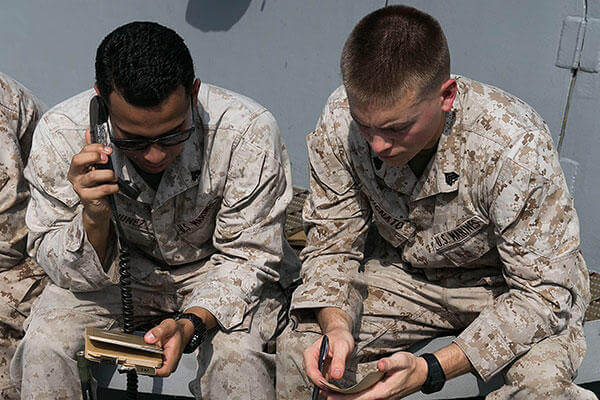Undisclosed location — Marines with the 120mm Mortars Platoon, Battalion Landing Team 2/6, 26th Marine Expeditionary Unit, embarked aboard the amphibious transport dock ship USS Arlington, conducted mission processing training aboard the USS Arlington in the Gulf of Aden, Dec. 8, 2015.
The platoon conducts this type of training weekly while afloat in order to maintain readiness to support the 26th MEU's missions. Currently, the MEU is deployed in support of maritime security operations within the 5th Fleet area of operations.
Since the platoon is unable to practice firing the 120mm expeditionary fire support system while aboard the USS Arlington, the Marines focus on the performance of the fire direction control center and utilizing proper communication techniques.
"This training is very beneficial," said Sgt. Joseph Lamberty, the platoon sergeant with the Mortars Platoon. "It's hard as an artilleryman to maintain job proficiency while aboard ship, because we are unable to work with the guns and conduct gun drills. So we focus on communication exercises in order to maintain proficiency with the mission processing aspect of our job."
During the exercise, Marines serving as forward observers called fire missions to the FDC via radio in the same format that would be utilized in real-world scenarios. Once the FDC received the request for support by fire, they communicated the information to the recorders on the notional gun line, ensuring the fire mission assisted the troops on the ground requesting the support. The steps taken during the training simulated an actual fire mission from the call for fire to the rounds hitting target.
"The Marines in the FDC benefit from this training the most," said Lamberty. "This is realistic for them, because this is how they would receive call for fire from the forward observers and then pass it on to the gun line. What they are doing during this training is what they would be doing in the field."
The Marine serving as the recorder on the gun line is responsible for recording all the fire missions sent to that gun from the FDC. Marines within the FDC receive the requests for fire, document it, and pass it along correctly to the gun line within a timely manner.
"We make the best of what we have while on ship," said Cpl. Ryan Gilligan, a fire direction control man with the platoon. "We can't get the guns out here to work with, but we work on everything behind the scenes, like the FDC, communicating with the gun line, and practicing calling for fire. It makes us well-rounded so we don't get rusty on ship. The training is very beneficial, because if we didn't do this training we can lose the knowledge that we have, so we maintain it anyway that we can. We try to do this training as much as we can."






























